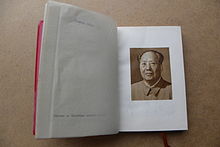User:TheNk22/Mao Warhol
| Mao Tse-Tung | |
|---|---|
| Artist | Andy Warhol |
| Year | 1972 |
| Medium | Silkscreen, acrylic |
| Movement | Pop art |
| Subject | Mao Zhedong |
| Location | Whitney Museum of American Art, Metropolitan Museum of Art, Andy Warhol Museum, Corcoran Gallery of Art in Washington |
Mao Tse-Tsung is a 1972 series of screenprints by the American artist Andy Warhol, depicting then Chairman of the Communist Party of China Mao Zhedong based on a 1959 photograph by Hou Bo. The total of 199 prints come in varying dimensions, ranging from (...).[1]
History
[edit]

Warhol came up with the idea of painting Mao Zhedong in July 1971, after then president Nixon announced his upcoming visit to China.[1] (...) The fame and mass ideology surrounding Mao attracted Warhol to portray Mao with the same attire of a Western pop icon, such as in his earlier prints of Marilyn Monroe and Elvis Presley. [2]
The source image for the screenprint was taken directly from the Little Red Book (...)
(His portraits of Mao are undeniably among the most influential and enduring of all his images. It was not until President Nixon’s announcement of his impending visit to China in July 1971 that Andy Warhol began to imagine painting Chairman Mao. He even made the stony observation that "Since fashion is art now and Chinese is in fashion, I could make a lot of money… Mao would be really nutty not to believe in it, it'd just be fashion but the same portrait you can buy in the poster store.” A year later, he produced a series of Mao portraits that today has become an icon to be found in many of the most prestigious art institutions and private collections across the globe.)
(After Nixon’s trip in 1972 which would lead to full diplomatic relations with China, Warhol undertook a group of portraits of Chairman Mao. Between 1972 and 1973, he created 199 Mao paintings in 5 set scales across 5 individual series, including the colossal Giant Mao canvases measuring 177 by 137 inches, the large 50 by 42 inch canvases, the smaller 26 by 22 inch canvases and the smallest 12 by 10 inches canvases. The present lot Mao made in 1973 belongs to the series of 22 paintings that were stretched on 50 by 42 in bars during his lifetime. Of the other paintings in this cycle, four are known to be held in the renowned public collections including the Andy Warhol Museum in Pittsburgh, the Corcoran Gallery of Art in Washington D.C. and the Foundation Carmignac in Southern France, demonstrating the historical and creative importance of this group of daring and penetrating portraits.)
Analysis
[edit]Since fashion is art now and Chinese is in fashion, I could make a lot of money… Mao would be really nutty not to believe in it, it'd just be fashion but the same portrait you can buy in the poster store.
— Andy Warhol
(Through the use of bold colours that is closely associated with communism and which echo the colour scheme of the People’s Republic flag, the present work is a distinctly wonderful example of the artist’s oeuvre. Andy Warhol gave each image in this series its unique characteristics, but only two other paintings from this series located in the collection of the Andy Warhol Museum in Pittsburgh give off comparably evocative and audacious colour tones. However, neither of them carries the highly expressionistic and flamboyant handling of paint as well as the artist’s resolution and confidence exuded in the present lot. Three distinct main colours, a strikingly intense red, vivid gold and a rather calm and subdued earthy brown are separated by the sharp black outlines of Mao’s features. The bright golden colour accentuating Chairman Mao’s face is reminiscent of sunshine, as if he is enveloped by rays of a holy and enlightened halo, while the dominating red across the surface of his tunic, a symbol of the Eastern equivalent to the Western business suit, brings to mind the famous unofficial national anthem of China during the Cultural Revolution in the 1960s: The East is Red, of which one part of the lyrics says: “The East is red and the sun rises; in China there emerges Mao Tse-tung.” The rich flashy tones and deep red hues of the acrylic paint contrasting the dark background epitomize the power and absolute authority of Chairman Mao. He stares directly at the viewer like he does in his official portrait hung in Tiananmen in Beijing, emanating an abundance of revolutionary spirit as well as a sense of triumph. However, if the viewer looks more closely, he will realize that Mao seems to have been stripped of the propaganda context and his intimidating aura is nothing but a faint memory. Whether intended or not, Warhol depicts the painting ironically fashionable in the West with his use of wide, colourful brushstrokes and hand drawn lines to give Mao a friendly face in the eyes of Americans. Warhol also decisively progressed from the stencilled, machine-like precision of the Liz and Marilyn portraits to a looser, abstract-expressionistic handling of paint. He vigorously applied the pigment onto the chairman’s tunic and face, creating an almost abstract frenzy of line, colour and movement. The touch of his hand, the material properties of the medium and the nuances of mixed and unmixed colour played an increasingly important role in the artist's late paintings and is particularly visible in the present work.)
https://www.artic.edu/artworks/47149/mao
https://www.tate.org.uk/art/artworks/warhol-mao-tse-tung-65355/3
Reception
[edit]1977 tate expo, 1976 death of mao
(shanghai warhol without mao)
Usage
[edit]The prints serve as the cover image for Don DeLillo's 1991 novel Mao II,
References
[edit]- ^ a b "Andy Warhol and Chairman Mao". Sotheby's. March 8, 2017. Retrieved February 23, 2020.
- ^ https://www.masterworksfineart.com/artists/andy-warhol/mao-portfolio-1972
